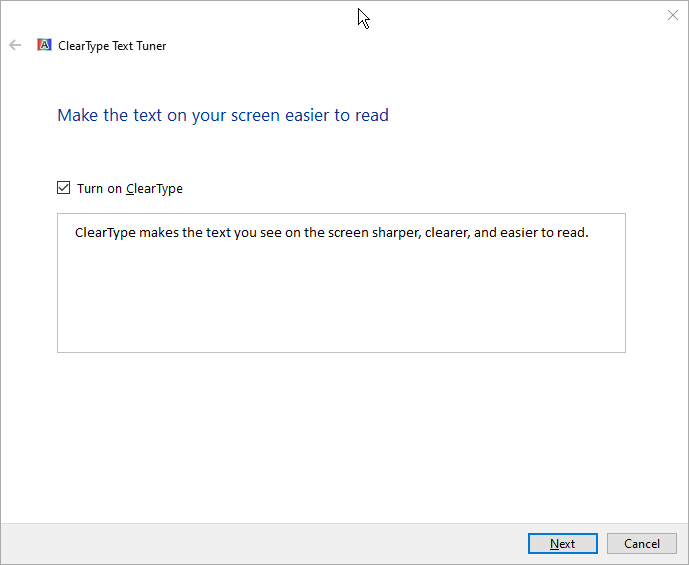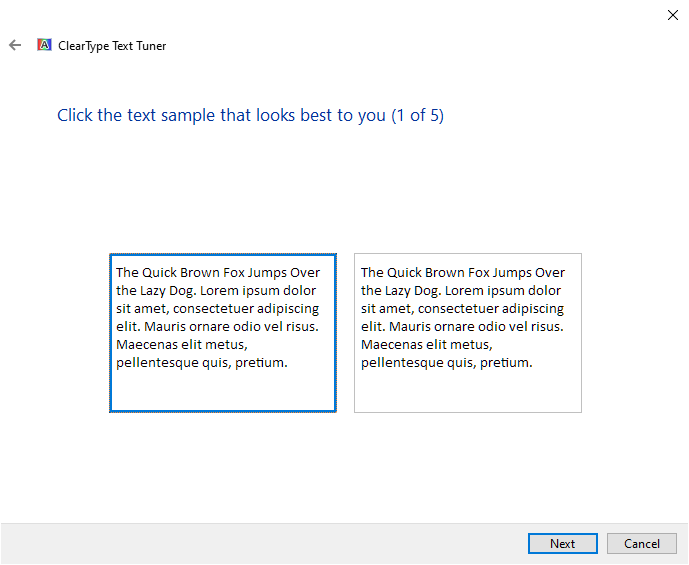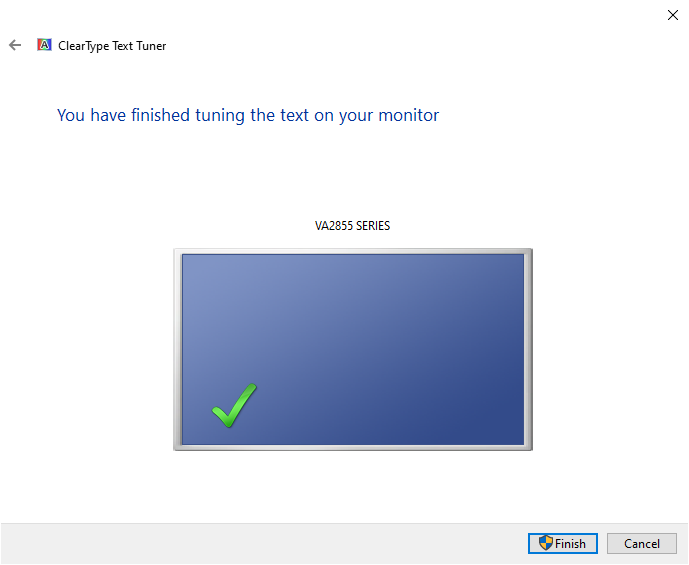Improving Text Sharpness with ClearType
Windows includes support for a Microsoft technology called ClearType. According to Microsoft sources, this technology "improves the readability of text" on devices that utilize LCD screens, such as laptops, Tablets, and flat-panel monitors. The technology doesn't represent a different type of font format, but a different way to render existing fonts on certain types of monitors. In fact, Microsoft states that the technology can make screen text look almost as sharp and clear as those printed on paper.
To find out if you would benefit from using ClearType, all you need to do is use the Windows ClearType Text Tuner. This wizard steps you through a series of steps that help you figure out what adjustments are best for displaying text on your device. To use the ClearType Text Tuner on a Windows 10 system, follow these steps:
- Type "Adjust ClearType Text" (without the quotes) in the Search box and press enter. Windows displays the ClearType Text Tuner window. (See Figure 1.)

Figure 1. The ClearType Text Tuner.
- Make sure the Turn On ClearType checkbox is selected. (It should be selected by default.)
- Click Next. Your monitor is checked to make sure it is set to its native resolution. If it is not, you may be directed to make some changes.
- Click Next. You start a series of five steps that are akin to letting the optometrist know which eyeglass lenses give you the best vision. (See Figure 2.)

Figure 2. Picking which text is clearer.
- Pick the text that looks best to you at each of the five steps. You'll need to click Next after each selection. (These steps are all completely subjective; it is up to you which samples look best.) When done, the wizard displays a screen to let you know it is finished. (See Figure 3.)

Figure 3. Done tuning text.
- Click Finish to dismiss the ClearType Text Tuner.
To use the ClearType Text Tuner on an earlier version of Windows, follow these steps:
- Display the Control Panel.
- Click the Hardware and Sound link.
- Click the Display link.
- Click Adjust ClearType Text, at the left side of the screen. Windows starts the ClearType Text Tuner.
- Make sure the Turn On ClearType checkbox is selected. (It should be selected by default.)
- Click Next. Your monitor is checked to make sure it is set to its native resolution. If it is not, you may be directed to make some changes.
- Click Next. You start a series of four steps that are akin to letting the optometrist know which eyeglass lenses give you the best vision.
- Pick the text that looks best to you at each of the four steps. You'll need to click Next after each selection. (These steps are all completely subjective; it is up to you which samples look best.) When done, the wizard displays a screen to let you know it is finished.
- Click Finish to dismiss the ClearType Text Tuner.
Author Bio
Allen Wyatt
With more than 50 non-fiction books and numerous magazine articles to his credit, Allen Wyatt is an internationally recognized author. He is president of Sharon Parq Associates, a computer and publishing services company. Learn more about Allen...
Understanding Manual Calculation
When you make changes in a worksheet, Excel automatically recalculates everything that may be affected by that change. If ...
Discover More
Sorting Text
Word makes it easy to sort the information that is contained in your document. Here's how to accomplish this.
Discover More
Stepping through Sentences
Need to select an entire sentence at once? You can do so by creating a short macro that does the task for you, or you can ...
Discover More
Sharing a Windows Theme with a Friend or Coworker
Being able to customize your theme is a great way to personalize your computer, but what if you want to share your theme ...
Discover More
Changing Regional Settings
Windows makes it easy to set your system to accurately reflect your regional settings. This tip sets you well on your way.
Discover More
Renaming Your Computer
When you buy a new computer, it typically has some obscure name that doesn't accurately reflect your personality. Or ...
Discover More



![]()
![]()
![]() This tip (6168) applies to Windows 7, 8, and 10.
This tip (6168) applies to Windows 7, 8, and 10.
Comments